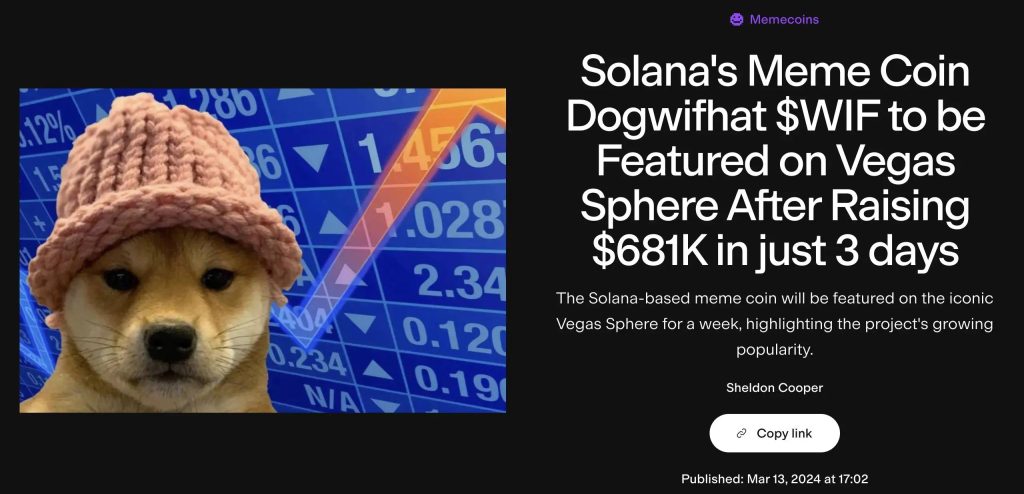
Forgotten WIF: The Life and Death of Meme Coins in the Attention Economy
There’s no gradual decline here—only a collapse.
On August 5, 2025, a pink knit hat will be auctioned. It’s not a designer piece or a historical relic, but the iconic headwear of Dogwifhat (WIF)—the Shiba Inu that once took the crypto world by storm.
Who could have predicted such a dramatic fall? In March 2024, an NFT of this ‘hat-wearing Shiba’ sold on Foundation for 1,210 ETH (≈$4.3 million) to top trader GCR, making it the platform’s second-highest sale ever. By November 2024, WIF boasted a $4 billion market cap, with its community raising nearly $700,000 to project the Shiba onto Las Vegas’ The Sphere megascreen.
Less than a year later, news of the hat’s auction barely rippled on Twitter. From fame to obscurity, WIF’s story reveals Web3’s brutal truth: For meme coins, being forgotten is true death.
From ‘Hat Dog’ to $4B: WIF’s Rise to Fame
In late 2023, a simple image began circulating on Crypto Twitter: a Shiba Inu in a pink knit hat. No one foresaw this casual meme would spawn a multi-billion dollar coin in months.
WIF’s explosion hinged on KOL Ansem. As one of crypto’s most influential voices, his frequent tweets about the ‘hat dog’ worked like magic—propelling WIF from obscurity to stardom.
The numbers speak for themselves: It hit a $1 billion market cap in just 81 days. In March 2024, the community crowdfunded $700,000 (exceeding the $650k goal) for The Sphere project. On March 31, WIF peaked at $4.83, becoming the talk of every crypto group.
Back then, WIF was a community totem. Holders believed it would be the next Dogecoin; the hat symbolized crypto’s ‘boundless possibilities.’
From Fame to Failure: The Las Vegas Nightmare
The downfall was swift.
Early 2025 saw Trump meme coins siphon market liquidity. February brought Trump’s tariff policy, triggering a crypto crash—meme coins suffered worst. But the final blow came in April: The Sphere project’s collapse.
It started with false hope in January: WIF’s official X account teased The Sphere projection, sending the coin up 34% in a week. Then Las Vegas Sphere officials crushed the dream: ‘No crypto合作 discussions.’ WIF plummeted 10% in an hour.
Trust evaporated. Community members demanded transparency on fund use. By April 1, project lead Edward canceled it and began refunds—$700k and a year of hope, gone. WIF dropped from $0.42 to $0.3, a new yearly low.
Worse, ‘traffic engine’ Ansem went silent. When the KOL stopped tweeting about WIF, and the community stopped creating memes, WIF faded from ‘it coin’ to ‘has-been.’
Survival in the Attention War: Multi-Dimensional Vitality
WIF’s tragedy highlights other meme coins’ survival strategies:
- Dogecoin: Endorsed by Elon Musk, ensuring constant limelight;
- Pepe: Embedded in internet culture via massive meme ecosystems;
- Pengu: Backed by Pudgy Penguins’ NFT community, Wall Street’s VanEck, and even partnered with Chinese toy firm Suplay for mainstream reach.
Their secret? Diversification—KOL support, community creativity, or institutional backing. WIF? Over-reliant on Ansem, no content ecosystem, no institutional favor. When hype died, nothing remained.
Conclusion: Being Remembered = Eternal Life for Meme Coins
The pink hat’s auction may be WIF’s last gasp. Its story mirrors a harsh reality: In crypto’s attention economy, meme coins live or die not by code, but by relevance.
Price up? Community party, KOL love. Price down? Infighting, desertion, death spirals. The only escape? Multi-dimensional vitality—don’t depend on one person’s tweets or a single event.
In a market chasing the next big thing, no one revisits ‘ancient history.’ For meme coins, being forgotten is the ultimate death sentence.
Read More《被遗忘的WIF,注意力经济下的meme币生死法则》
This content is AI-generated and does not constitute investment advice. Please exercise your own rational judgment.
链上探索《被遗忘的WIF,注意力经济下的meme币生死法则》
- Startup Commentary”Building LLMs: The Knowledge Graph Foundation Every AI Project Needs”
- Startup Commentary”The 17th Year of Tmall Double 11 and the New Map Rewritten by AI”
- Startup Commentary”How to Prepare Your Data for Artificial Intelligence”
- Startup Commentary”Small and Medium-sized Banks: “Cutting the Tail” in Loan Assistance”
- Startup Commentary”The Six AI Giants on Stage: AGI Is No Longer a “Future” Thing”




